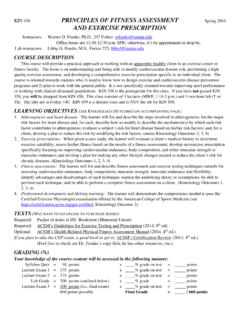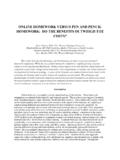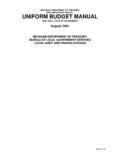Transcription of Documenting S Corporation Shareholder Basis
1 Documenting S. Corporation Shareholder Basis As Protection Against an IRS Audit American Institute of Certified Public Accountants Washington, DC. 5/24/2012. Basis for S shareholders The Basics: S Shareholder losses limited to Basis in Stock and Debt of the S corp. to the Shareholder [Sec. 1366(d)]. Basis of stock reduced first, then debt Any current undistributed income restores prior Basis reductions of debt before increasing stock Basis [Sec. 1367(b)(2)]. Note that Schedule M-2 is not a reflection of Basis Example 1. Losses offset stock Basis first, then debt Shareholder withdraws $25,000 of the current income of $40,000: Stock Debt Original Basis $50,000 $100,000.
2 Prior year losses (50,000) (30,000). Current income: $40,000. Less distribution (25,000). Excess restores Basis in debt $15,000. S Shareholder Stock Basis Calculated at Shareholder level, per Shareholder Losses and deductions limited by Basis : Carry forward indefinitely Treated as passing from S corp. to that Shareholder in next year [IRC Sec. 1366(d)]. Gain on sale of S corporate stock does not increase Basis or otherwise allow use of suspended losses Carryover loss expires when Shareholder gives all of his/her stock to another Exception for divorce [IRC 1366(d)(2)(B)].
3 S Shareholder Stock Basis Stock Basis calculated per share Spillover rule: But if reductions to a share exceed its Basis , excess applied to reduce Basis of other shares, but not below zero [Reg. (c)(3)]. Example 2: Spillover Rule Shareholder C. Sh. 1 Sh. 2 Sh. 3 Total Basis Jan. 1 $ 0 $20K $50K $70K. Loss of $30K: 1) Pro-rate (10K) (10K) (10K) (30K). 2) Spillover 10K (5K) (5K) 0. Basis Dec. 31 $ 0 $ 5K $35K $40K. Adjustments to Stock Basis General rule: Income +. Distributions < - >. Nondeductibles < - > May elect to reorder per Deductibles < - > Reg. (g). No requirement to c/o nondeductibles Election to reorder Basis adjustment Consequence: get deductibles first but c/o nondeductibles if insufficient Basis .
4 Permanent election Ex 3-Order of Adjustments to Stock Basis Election Gen. Rule To Reorder Beg. Basis $40,000 $40,000. Nondeductibles (15,000). Deductibles ($30,000) (25,000) (30,000). Nondeductibles (10,000). Ending Basis $ 0 $ 0. Carryforward $ (5,000) $ (5,000). Without election to reorder, no requirement to c/o non- deductibles (if nondeductibles exceed the Basis , prior to applying deductible expenses). Deductibles reduce stock Basis b/4 nondeductibles w/ election Consequence: Nondeductibles last, but carryforward if insufficient Basis Permanent election Election is per Shareholder No Earnings & Profits If there are no C Corporation E&P, AAA is not significant to current distributions AAA computation will be necessary if S corp reorganizes tax-free with another corp that has E&P.
5 AAA is also important if the Corporation revokes the S election and distributions are made within the post-termination transition period Tax-free distributions during the PTTP are limited to AAA. and Shareholder Basis Basis in stock is the only limiting factor to current tax-free distributions S Corp w/ Accumulated E&P. If the Corporation has accumulated earnings and profits, AAA is relevant Accumulated E&P can only be created while the Corporation was a C Corporation Not equal to retained earnings Determined instead based upon earnings and profits accounting methods When a C Corporation elects S status, compute earnings and profits S Corp.
6 Distributions S corp. with no prior C corp. E&P. Distributions are first a return of stock Basis Excess treated as a gain from sale of stock [IRC Sec. 1368(b)]. Example 4. Stock Basis Beginning Jan. 1 $ 10K. Income per K-1 50K. Distribution of $65K: 1st: Rtn. of Basis (60K) Tax free 2nd: Capital gain 0 $5,000 LTCG. $ 0. S Corp. Distributions Ordering rules if prior C corp. E&P: S Corp. Indiv. Shareholder Adj. Acct. (AAA) 1. a. To stock Basis b. Excess = gain E&P 2. Dividend 3. a. To stock Basis b. Excess = gain S Corp. Distributions Definition of AAA (Reg. ): Quick definition: Undistributed S net income Starts at $0 on first day of first S year AAA can be negative due to losses/ deductions (but not due to distributions).
7 Corporate level account no s/h entitled to AAA. OAA Other Adjustments Account S Corp. Distributions Example 5: Net Income S Corp. Sole Shareholder AAA AE&P Basis Income Jan. 1 $10,000 $15,000 $12,000 $ 0. Net income-1st 6,000 6,000 6,000. Distribution (9,000) (9,000). Dec. 31 $ 7,000 $15,000 $ 9,000 $6,000. S Corp. Distributions Example 6: Net Loss S Corp. Sole Shareholder AAA AE&P Basis Income Jan. 1 $10,000 $15,000 $12,000 $ 0. Distribution-1st (9,000) (9,000). Net Loss (6,000) (6,000) (3,000). Dec. 31 $(5,000) $15,000 $ 0 $(3,000). + Carryover loss $(3,000). S Corp.
8 Distributions Example 7: Distribution Exceeds AAA. S Corp. Sole Shareholder AAA AE&P Basis Income Jan. 1 $10,000 $15,000 $12,000 $ 0. Distrib. $13K 1) (10,000) (10,000). 2) (3,000) 3,000. Net Loss (6,000) (2,000) (2,000). Dec. 31 $(6,000) $12,000 $ 0 $(1,000). + Carryover loss $(4,000). S Corp. Distributions Example 8: AAA exceeds Basis S Corp. Sole Shareholder AAA AE&P Basis Income Jan. 1 $10,000 $15,000 $ 8,000 $ 0. Distrib. $13K 1) (10,000) (8,000) 2,000 LTCG. 2) (3,000) 3,000 DIV. S Corp. Distributions Example 9: Negative AAA. AAA AE&P. Jan. 1 $(100,000) $ 50,000.
9 Net Income 80,000. Distribution: $35K (35,000) Div. Dec. 31 $ 20,000 $ 15,000. S Corp. Distributions Example 10: Distribution of exempt income S Corp. Sole Shareholder AAA AE&P Basis Income Jan. 1 $10,000 $50,000 $12,000 $ 0. Taxable Income 5,000 5,000 5,000. Exempt income ($50K) 0 50,000. Distribution: $40K (15,000) (25,000) (15,000) 25,000. Dec. 31 $ 0 $25,000 $52,000 $30,000. Other Loan Basis Rules Only loans outstanding at year-end provide Basis for losses If multiple loans by a Shareholder , loss reduces each debt in proportion to its ending Basis If multiple loans with prior Basis reduction, current income: 1.
10 First increases Basis of any loan currently repaid 2. Then increases loan Basis in proportion to prior Basis reductions (Reg. ). Example 11. Shareholder C. Loan Loan Loan 1 2 3. Face $10K $20K $20K. Prior losses (10) (20) (5). Basis Jan. 1 $ 0 $ 0 $15K. Current income: $29K. 1. Loan 2 repaid ($20K) + $20K. 2. Allocate excess ($9K) +$ 6K +$ 3K. Allocated based upon prior losses (10/15) (5/15). Repay Reduced- Basis Debt Partial repayment is proportionately gain and return of Basis Rev. Rul. 68-537. Character of gain: Open advances (unwritten debt): Ordinary Income [Rev Rul 68-537].

















